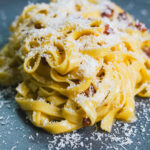Tagliatelle Carbonara – a twist on the classic spaghetti version and made with egg yolks, parmesan, and pancetta. Impress with this quick and delicious tagliatelle carbonara recipe…
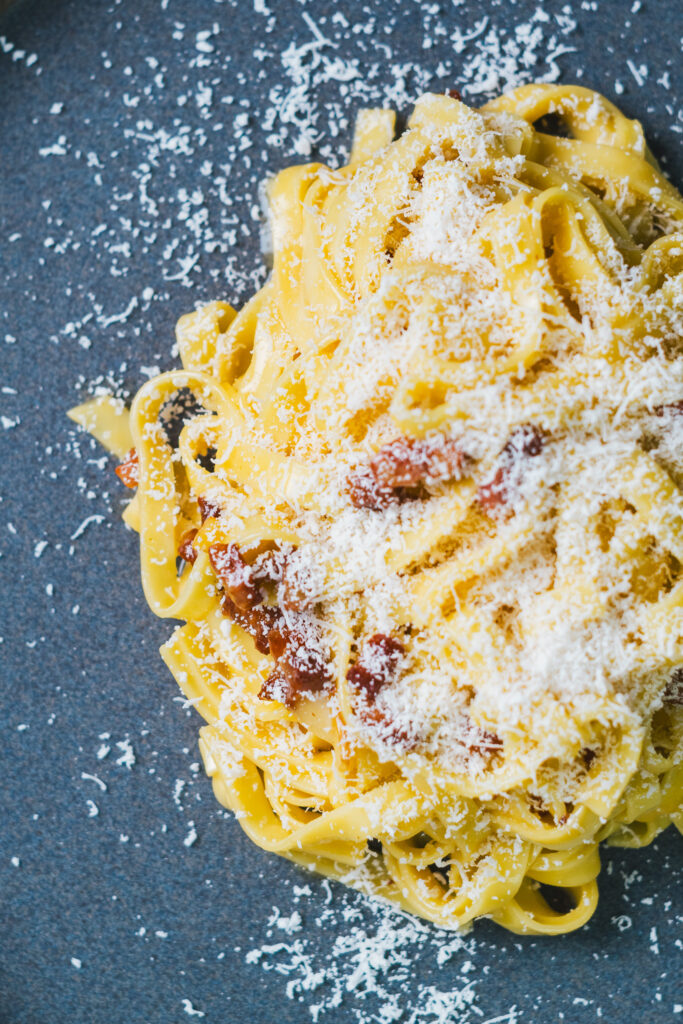
Welcome to the world of homemade Italian pasta dishes! If you’re craving a creamy and indulgent meal, look no further than the classic Tagliatelle Carbonara. This dish is a delicious combination of silky pasta, rich egg sauce, crispy pancetta, and nutty cheese. While it may sound complicated, creating this Italian favourite at home is easier than you think. In this post, we will guide you through each step of the process, from understanding the origins of Tagliatelle Carbonara to perfecting the dish in your own kitchen. Get ready to impress your family and friends with your culinary skills!
Understanding the Classic Tagliatelle Carbonara Recipe
The Tagliatelle Carbonara recipe is a traditional Italian pasta dish that has become a favourite worldwide. It originated in the Lazio region of Italy, specifically in Rome, and is believed to have been created by charcoal workers. This simple yet delicious pasta dish features a creamy sauce made with egg yolks, grated pecorino cheese, black pepper, and cooked pasta. It is usually served with spaghetti. The dish is known for its silky smooth sauce and the perfect balance of flavours.
The Origins
The origins of a traditional carbonara recipe can be traced back to the charcoal workers of the Lazio region in Italy. These workers needed a substantial and hearty meal to sustain them during their long and laborious days. With simple ingredients, they created a dish that is now loved by many. The combination of pasta, eggs, parmesan cheese, and black pepper quickly gained popularity, not only for its taste but also for its simplicity. Over time, the dish evolved, and various regional variations emerged, each with its own unique twist. Today, Tagliatelle Carbonara is enjoyed worldwide, and it continues to be a classic dish in Italian cuisine.
Why it’s a Must-Try Dish
Tagliatelle Carbonara is a must-try dish for pasta lovers for several reasons. First and foremost, the creamy texture of the sauce is simply divine. The combination of the egg mixture and the cheese creates a velvety richness that coats each strand of pasta, making every bite a delight. Whether you’re a fan of traditional spaghetti carbonara or looking to explore new pasta dishes, Tagliatelle Carbonara is a simple recipe using basic ingredients that should not be missed.
Gathering Your Ingredients
Gathering all the ingredients for your dish is essential. From selecting the best quality items to preparing them for cooking, each step matters in creating a flavourful meal. Ensuring you have the right tools, like a large pan and mixing bowl, is crucial. Remember to follow the recipe closely, especially when it comes to adding a pinch of salt or cheese mixture. Heating the pan over medium-high heat and cooking the pasta al dente with a tablespoon of salt will elevate the dish’s taste.
Types Of Pork
Traditionally carbonara uses guanciale – pancetta is a good substitute. If you can’t find pancetta, bacon will work. I like to use smoked pancetta and smoked bacon when making a carbonara. You could use unsmoked if you prefer. We need the flavour from that salty pork in there!
Tagliatelle Pasta
You can use fresh or dried here, just cook as per the package instructions. Fresh pasta takes a lot less time to cook. You can also use homemade tagliatelle pasta or spaghetti noodles will work here too.
Parmesan
Look for fresh Parmigiano Reggiano. Don’t be tempted to use any Italian hard cheese; it will not create the silky sauce we are looking for or provide as good a flavour.
Garlic Cloves
This helps to provide a subtle extra garlic flavour to the sauce
Pasta water
The magic gold stuff! This is what will bring ingredients together to make a sauce. For this recipe, you will need a large pot of salted water and to reserve a large mug of pasta water for making the sauce.
Pancetta
Smoked diced pancetta will bring a lovely saltiness to the dish. The bacon fat rendered from the pancetta provides great flavour to the sauce. You can also use pork jowl or guanciale if you can find it, but pancetta and smoked bacon are great alternatives. Cut into nice thick slices or lardons depending on how large you want your pieces of bacon. I like to use small pieces of pancetta in my recipe.
Egg yolks
Use room-temperature eggs, not cold eggs, as using cold eggs can lead to a lumpy sauce. The egg white is not needed in this recipe, so save them for making meringues; don’t throw them away.
Black Peppercorns
A good grind of black pepper is used to finish the dish and give a little bit of finishing heat
How to make Tagliatelle Carbonara
Carbonara Tagliatelle is a technical dish to get right, but is well worth it to get that silky smooth sauce that is nice and creamy, but with no cream! The key to a good carbonara is to get the temperature of the pan not too high so you don’t scramble your egg sauce. As you toss the pasta and the egg yolks, the gentle heat of the pan helps to cook the yolks gently and as they cook, they thicken and coat the pasta in a rich sauce.
How to Cook Carbonara
Cook the pasta in a large pot of boiling salted water until al dente. While the pasta cooks, mix eggs, Parmesan cheese, and Pecorino cheese in a large bowl. In a large skillet over low heat, cook pancetta until crispy. Once the pasta is cooked, reserve a cup of pasta water, then drain the pasta. Toss the hot pasta in the pan with pancetta over medium heat. Add the egg and cheese mixture, stirring constantly to create a silky sauce. If needed, add some reserved pasta water for consistency. Serve hot and garnish with extra cheese if desired.
- Add grated parmesan to the egg yolks and combine
- Begin frying the pancetta with the garlic before you cook the pasta. Remove the crushed garlic clove once the pancetta is cooked
- Cooking the Pasta
To cook the pasta, boil it in a large pot of water until it’s 2 minutes shy of being cooked al dente. Utilize reserved pasta cooking water to adjust your sauce’s texture. Drain the pasta using a slotted spoon for best results. Ensure the pasta attains the ideal heat level for blending with the sauce, mastering the timing crucial for a flawless carbonara.
- Don’t forget to reserve some pasta water, this is essential for tempering the egg yolks and getting the right consistency to the sauce
- Remove the pan from the heat. This is the most important step. If the heat in your pan is too high, you will scramble your egg yolks and you will end up with a lumpy sauce – nobody wants that!
- Don’t use extra oil to fry the pancetta. There is plenty of bacon fat in it which will render down and give plenty flavour to the sauce.
- Add some pasta water to the egg yolk and cheese mixture. This will help temper the eggs and stop them scrambling
- Add the pasta and egg yolk mixture to the pan and toss to combine. As you toss the residual heat from the pan and the heat of the pasta will cook the eggs, thickening the mixture into a silky smooth sauce. If the sauce gets too thick, you can always add more pasta water. It should take around 2-3 minutes of pan tossing to cook the eggs and create that silky sauce.
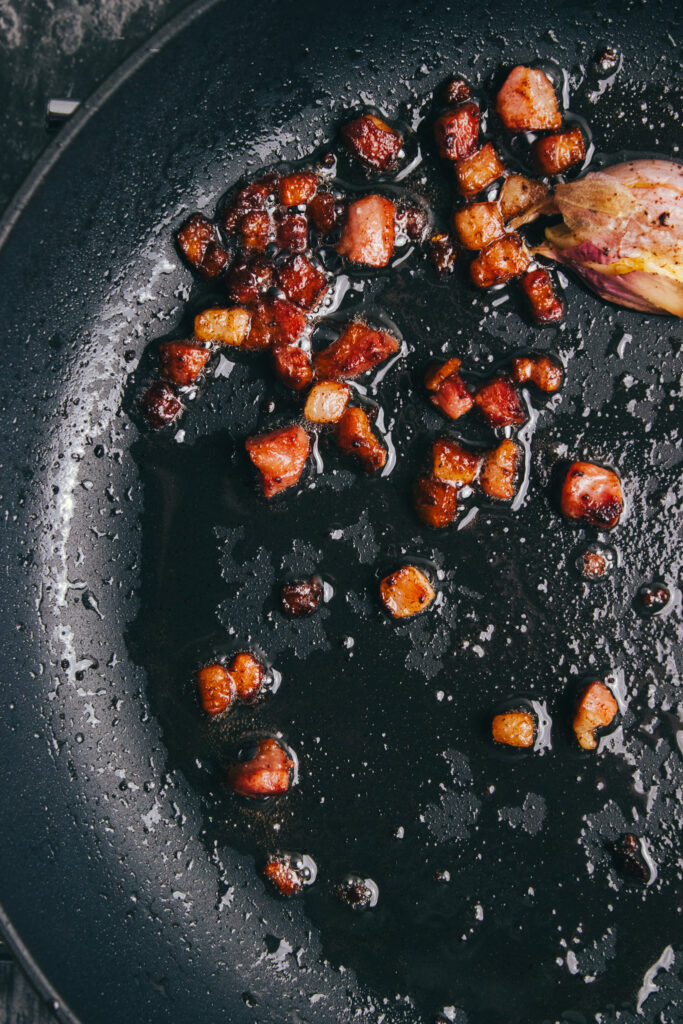
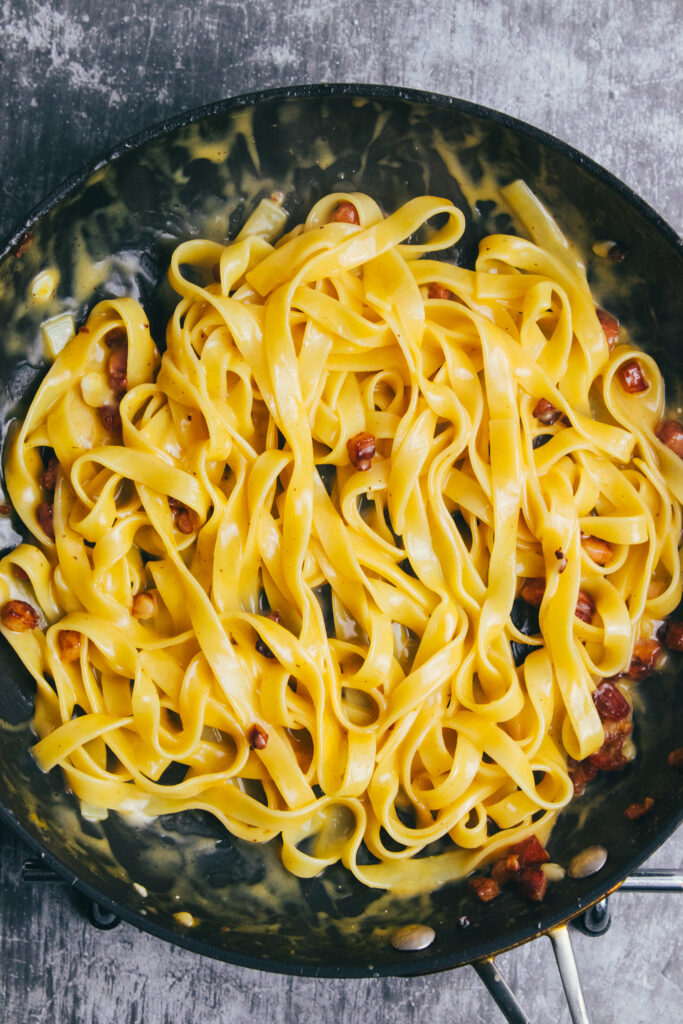
Perfecting Your Dish
Expert Cooking Tips for Achieving Perfection: Employ a large pan over medium heat to create the cheese mixture. Start by combining parmesan cheese, pecorino cheese, and cooked pasta in a large bowl. Using pasta cooking water, achieve a silky sauce consistency. When the pasta is al dente, transfer it to the pan with the cheese mixture. Toss gently on low heat until the sauce coats the pasta evenly. Remember to balance flavours with a pinch of salt, and voilà – a dish worth sharing!
Expert Cooking Tips
To master achieving an al dente texture, cook the pasta in a large pot until almost done. Before draining, reserve some pasta cooking water for the sauce’s creaminess. For a smooth carbonara sauce, opt for fresh eggs at room temperature. Off the heat, combine the hot pasta with the egg and cheese mixture to prevent scrambling. Lastly, ensure the pork belly is perfectly crispy and golden brown in the frying pan for a delightful crunch.
Common Mistakes to Avoid
Adding cheese directly to the pan on medium heat may cause clumping. Ensure the silky sauce by not overcooking; it should be creamy. Avoid rinsing the pasta post-cooking to preserve starch for the sauce. Opt for freshly grated parmesan cheese instead of pre-grated for better flavor. Remember to reserve pasta cooking water for adjusting sauce consistency.
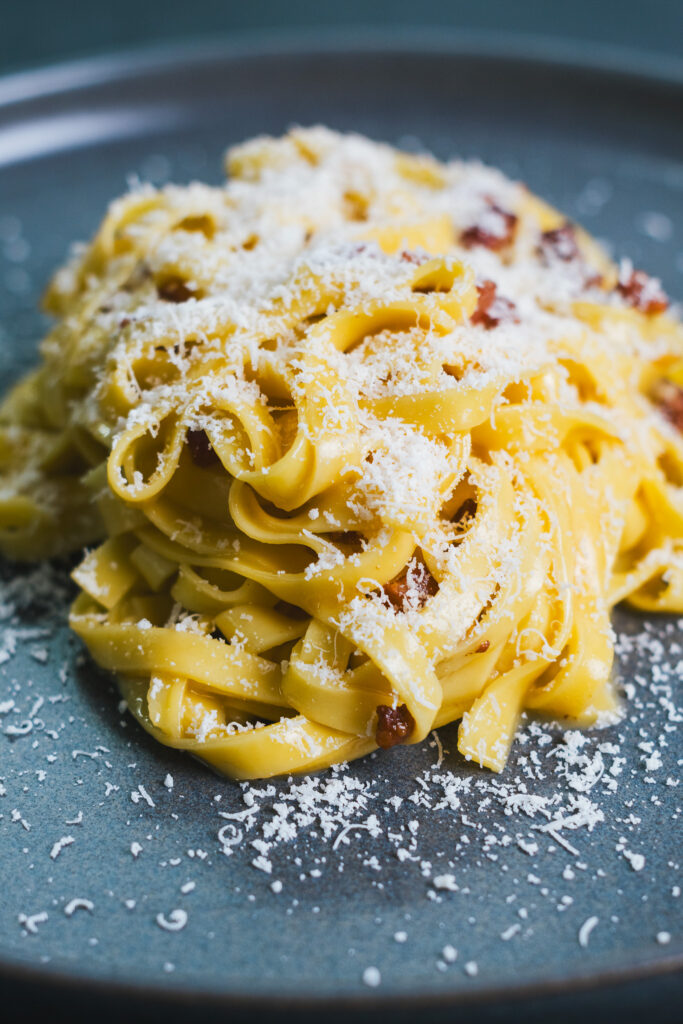
Exploring Variations of Tagliatelle Carbonara
Variations of the classic pasta dish can include different types of cheese in the sauce, such as pecorino or parmesan, to enhance the flavour profile. Experimenting with the cooking technique, like using high heat to create a crispy texture on the pancetta, can add a unique twist. Adding fresh herbs like parsley or basil at the end can elevate the dish’s freshness and aroma. These variations allow for a personalized touch to the traditional tagliatelle carbonara recipe.
Adding a Twist to Your Recipe
For a creative twist, swap out the traditional pancetta or guanciale with bacon or mushrooms for a vegetarian-friendly alternative. Enhance the dish by incorporating vibrant herbs like parsley or basil. Elevate the flavours further by experimenting with unique cheeses such as pecorino Romano or Parmesan. Boost the nutritional value and texture by adding veggies like peas or asparagus to your carbonara.
Adapting to Dietary Restrictions
Adapting to dietary restrictions involves swapping traditional pasta for gluten-free or veggie-based options, exploring dairy-free alternatives like almond milk or nutritional yeast instead of cream and cheese, opting for turkey bacon or veggie bacon bits, tossing in extra veggies such as peas or spinach for added nutrients, and trying diverse seasonings to tailor the dish to personal preferences.
Pairing Your Dish
Ideal wine pairings can elevate the flavours of your dish, enhancing the dining experience. Complimentary side dishes can add depth to your meal, creating a well-rounded culinary adventure.
Ideal Wine Pairings
When pairing wine with your Tagliatelle Carbonara, consider a light to medium-bodied white like Pinot Grigio or Chardonnay. The wine’s flavours can enhance the creamy, savoury notes of the dish. For non-alcoholic options, try sparkling water with lemon or a fruity mocktail. Serve and enjoy the wine alongside your homemade Carbonara for a delightful dining experience.
Complimentary Side Dishes
Enhance your tagliatelle carbonara experience with delightful side dishes. Consider pairing your pasta with a fresh garden salad tossed in a tangy vinaigrette. For a heartier option, try serving garlic bread to complement the creamy flavours of the carbonara. Elevate your meal with roasted vegetables like asparagus or cherry tomatoes drizzled with olive oil for a burst of colour and freshness. Experiment with different side dish combinations to find the perfect accompaniment to your Italian culinary creation.
Should There Be Garlic In Carbonara?
A lot of carbonara purists say no garlic should be added. I like to add a crushed whole clove to the cooking pancetta then discard it before making the sauce. This way you get just a hint of garlic flavour in the background.
How Do You Know The Egg Is Cooked In Carbonara?
The easisest way to tell is when the sauce comes together in a nice silky emulsion of cheese and pasta water and coats the pasta strands. If you end up with lumps in your sauce, then the heat is too high and the eggs are overcooked. The heat provided by the hot pasta water mixture and the hot pasta when tossing together is enough heat to cook the eggs.
Hints & Tips
Use plenty pasta water – a common mistake is not to use enough pasta water when you mix the egg and cheese and you don’t create enough sauce
Too high a pan temperature – If the pan temperature is too high, the egg cheese mixture will scramble. It is all about timing and remember to switch the heat off the pan once the pancetta is crispy!
Don’t get rid of the pancetta fat – this is what will give extra flavour to the sauce. A lot of people discard this and lose valuable flavour to their sauce
Don’t go overboard with the cheese – the cheese is salty but so is the pancetta. Too much cheese and the dish will become far too salty.
How to stop the eggs from curdling – if you find it difficult to get the right heat level in the pan and keep scrambling your eggs, a method to try is using a double boiler. Place a heatproof mixing bowl over a pan of barely simmering water to provide gentle heat. You can then add the pancetta and egg yolk mixture with the pasta water to this and gently heat till it thickens to your desired consistency. You then just toss the pasta through it.
Can I Reheat Carbonara?
The short answer is yes, you can reheat carbonara. However, a few things to keep in mind ensure that it remains just as tasty as when it was first made.
When reheating carbonara, it’s important to do so gently and slowly to avoid curdling the eggs in the sauce. The best way to reheat carbonara is on the stovetop over low heat. Simply add a splash of cream or milk to the pan before adding the pasta, and toss everything together until heated through.
Alternatively, you can reheat carbonara in the microwave by placing it in a microwave-safe dish and heating it on medium power for short intervals, stirring between intervals until warmed through.
It’s worth noting that reheated carbonara may not have quite the same creamy texture as when freshly made, but it will still be delicious! Just store any leftover carbonara properly in an airtight container in the refrigerator and consume within 2-3 days.
FAQ’s
Cream, bacon, pancetta, garlic…the list goes on. Cream is a big no no, there is no need for it. The egg yolks and cheese with some pasta water give that silky mouthfeel without using cream. Guanciale is what is used traditionally but it can be hard to find, so don’t worry, bacon or pancetta is perfectly fine and is delicious to use for carbonara!
Traditionally it is usually 1 egg yolk per serving. To make it extra luxurious, I like to use two per serving. You can use one if you prefer.
Yes. Keeping the eggs at room temperature will allow them to mix more easily with the cheese, which should be at room temperature also.
Pecorino Romano cheese is used more traditionally in carbonara. If you have it, it is great as an alternative to parmesan.
Traditionally, spaghetti is used, but you can use your favourite pasta. I like to use fresh pasta because I love the flavour. Alternatives to use could be bucatini, fettuccine or linguine.
The golden rule is to not scramble your eggs when making a carbonara. If the heat gets too high, you will scramble the sauce and lose the silky consistency you are looking for.
If you would like to keep it traditional, then peas should not be added. I love flavourful food, and peas can be delicious when added to your carbonara. Experiment and express yourself through your food.
Traditional carbonara uses only the yolks, but some people add whole eggs to their sauce. I prefer to use just the yolks.
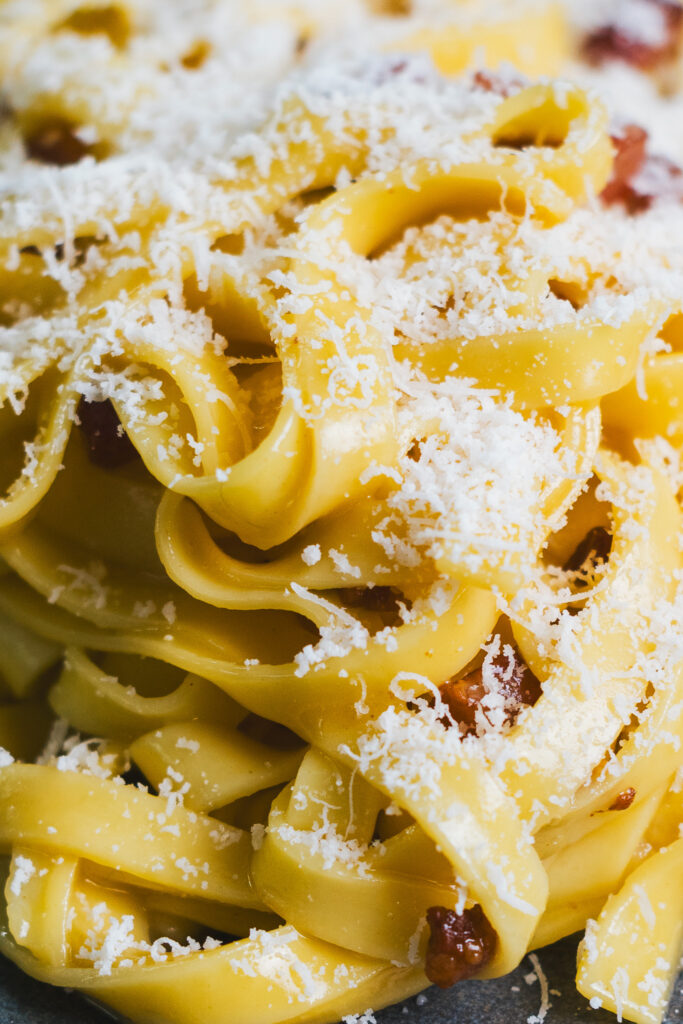
Try Another Recipe
Tagliatelle Carbonara
Ingredients
- 200 g tagliatelle
- 4 large egg yolks
- 50 g grated parmesan
- 80 g diced smoked pancetta
- 1 cup of pasta water
- 2 crushed garlic cloves
Instructions
- Start by cooking the pancetta first. Place in a non-stick frying pan over medium heat with the garlic and cook until crispy (around 5 minutes or so) There is no need to add oil, there is enough fat in the pancetta which will render down once in the pan.
- Once the pancetta starts to get some colour, add the tagliatelle to a pot of boiling well salted water and cook until al dente (usually around 10 minutes, check your pasta packet for instructions)
- When the pancetta is ready, turn off the pan and remove the garlic and set aside for a few minutes whilst the pasta continues to cook
- Whilst pasta is cooking, whisk together the egg yolks and grated parmesan with a touch of pasta water
- When pasta is ready, drain and reserve a cup of the pasta water
- Add the pasta to the pan with the pancetta and toss
- Add the egg yolk mixture and a splash of the pasta water and toss until creamy and the strands of pasta are coated in the sauce
- Serve immediately in warm bowls and finish with some fresh grated parmesan and cracked black pepper.
Notes

Hi, I’m Paul! I’m a passionate home chef, recipe developer, and food lover who believes that cooking should be fun, rewarding, and stress-free! Through Scoffs & Feasts, I share my favorite tried-and-tested recipes, cooking tips, and troubleshooting advice to help home cooks gain confidence in the kitchen. Whether you’re a beginner or an experienced foodie, I hope my recipes inspire you to try something new.

